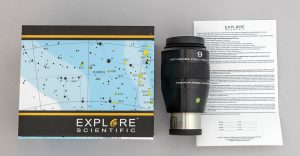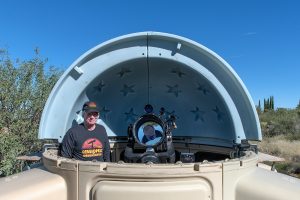In Astronomy Technology Today, Issue 6, I reviewed the Explore Scientific 2″ 14mm 100° and 2″ 5.5mm 100° eyepieces. In that review I mentioned the Explore Scientific 2″ 9mm 100 eyepiece that I have used and loved for many years. This time I am reviewing the Explore Scientific 2″ 9mm 120° eyepiece that Explore Scientific provided.

As with other Explore Scientific eyepieces, the 2″ 9mm 120° eyepiece comes in a lovely box that protects the eyepiece during shipment (Image 1). Unlike with the other Explore Scientific eyepieces I have reviewed, there was no cloth bag included. The eyepiece is waterproof (Argon-purged). A warranty card is included, and Explore Scientific provides a fully transferrable unlimited lifetime warranty on waterproof eyepieces, if registered within 60 days of purchase, with anytime free service and repurposing of an eyepiece that is returned for their trade-up program.
As seen in Image 2, the height of the two 9mm eyepieces is nearly identical although the 120° eyepiece is much wider and heavier. Your telescope and mount will need to be able to handle the weight.

The eyepiece has a 120° apparent field-of-view, which is an amazing design. I measured the actual field-of-view of the 2″ 9mm 120° eyepiece when used on my 12″ f/8 (focal length 2438mm) telescope as 35.4 arc min. With the eyepiece eyecup extended I could not see the entire field-of-view without “looking around the corner”. With the eyecup folded down I could see the entire field-of-view. However, with the eyecup folded down the chance of getting oils from eyelashes onto the glass surface is increased. The view is very sharp nearly to the edge of the field-of-view.
Viewing the Full Moon was impressive with the entire disk visible. No matter in what direction I looked in the eyepiece there was the Moon’s surface. And with the 120° apparent field-of-view you do need to actually look around in all directions. The views along the lunar limb at Full Moon were incredible. Many mountains rising above the limb were visible at a glance with the wide field and high magnification.
When I viewed Jupiter, the Great Red Spot (Little Pink Spot) was visible and the four Galilean Moons were spread out across the entire field-of-view even though the moons were widely separated. The disks of the moons were visible at the magnification of 271X with my telescope, providing a very impressive high magnification view. Saturn was a nice bright view at the high magnification.

The tube diameter for the 2″ 9mm 120° eyepiece (3.11 inches) is too large for most smartphone adapters. I could not get a handheld afocal image showing anywhere close to the entire field-of-view. I was able to take handheld iPhone afocal photographs (single frame, not stacked) of Jupiter (Image 3) and Saturn (Image 4). (Seeing was not good when I was photographing the planets.)
I enjoy observing galaxies, nebula, globular clusters, and open star clusters. Using the 2″ 9mm 120° eyepiece I viewed the galaxies M85 and NGC4457. I was able to view Supernova 2020nlb in M85 and Supernova 2020nvb in NGC4457 at 271X. The bright field-of-view and the high magnification made visually separating the supernovae from the galaxies easy.
M57 (Ring Nebula) was an incredible view at the high magnification. The nebula was bright, floating in a wide field view of stars. M13 (Great Globular Cluster in Hercules) was impressive with many cluster stars visible. The same was true for M4 (globular cluster). M6 (Butterfly Cluster, open star cluster) was an immersive experience with many stars visible. M16 (Eagle Nebula) showed the nebula faintly visible with a nice view of the nearby star cluster.

The very wide field of the 9mm 120° eyepiece is unnecessary when viewing planets, but that same very wide field-of-view combined with its bright high magnification view make this an ideal eyepiece for observers who like to “star hop” to locate faint objects. Viewing the Moon, bright and large galaxies and nebulae, and star clusters can all benefit from this very wide field-of-view, if you can use it. Some users may not be able to see the wide apparent 120° field, even with the eyecup folded down. But if you can, you will be amazed at the views through this eyepiece.
The Explore Scientific 2″ 9mm 120° eyepiece costs $1000 (USD) versus $550 (USD) for the Explore Scientific 2″ 9mm 100° eyepiece. Either eyepiece will provide outstanding high magnification views of many objects. The Explore Scientific unlimited lifetime warranty will protect your purchase.
###
 About the Author: Mike Weasner started in astronomy at the age of six when his older brother, Paul, would show him the stars from their southern Indiana home. As a Christmas present in 1961, Mike’s mother gave him an Edmund Scientific 3″ Newtonian Telescope which he still uses today. When Mike was 14 Paul got him a subscription to Sky & Telescope which continues uninterrupted through today. He has a B.S. in Astrophysics from Indiana University and following college, he entered into the US Air Force, where he served as a fighter pilot, instructor, and a manager in the Air Force’s Space Shuttle Program Office. He hosts the website “Cassiopeia Observatory” – www.weasner.com – where you can see reports of his sessions in his observatory, his astrophotography, and product reviews.
About the Author: Mike Weasner started in astronomy at the age of six when his older brother, Paul, would show him the stars from their southern Indiana home. As a Christmas present in 1961, Mike’s mother gave him an Edmund Scientific 3″ Newtonian Telescope which he still uses today. When Mike was 14 Paul got him a subscription to Sky & Telescope which continues uninterrupted through today. He has a B.S. in Astrophysics from Indiana University and following college, he entered into the US Air Force, where he served as a fighter pilot, instructor, and a manager in the Air Force’s Space Shuttle Program Office. He hosts the website “Cassiopeia Observatory” – www.weasner.com – where you can see reports of his sessions in his observatory, his astrophotography, and product reviews.
And to make it easier for you to get the most extensive news, articles and reviews that are only available in the magazine pages of Astronomy Technology Today, we are offering a 1 year magazine subscription for only $6! Or, for an even better deal, we are offering 2 years for only $9. Click here to get these deals which only will be available for a very limited time. You can also check out a free sample issue here.

